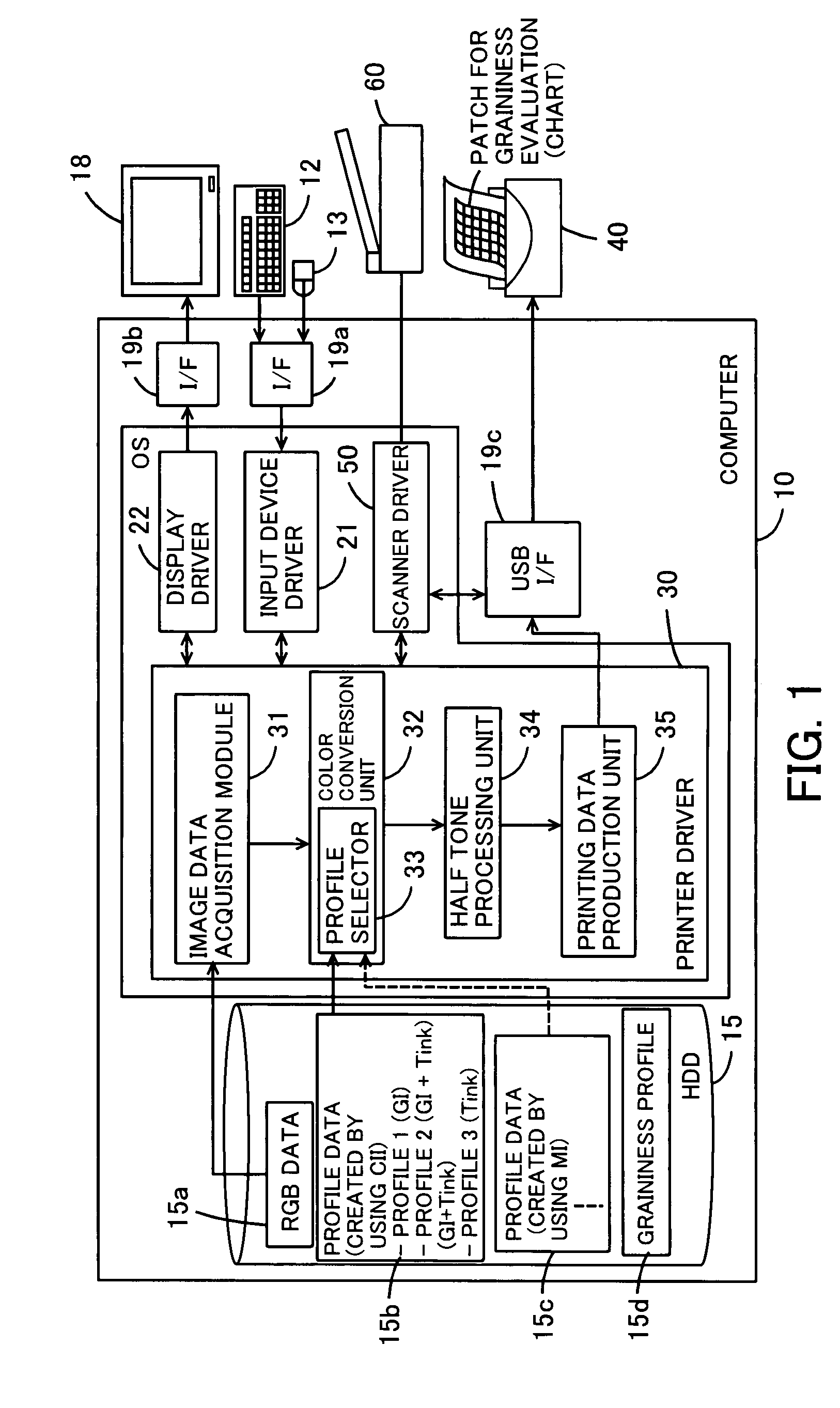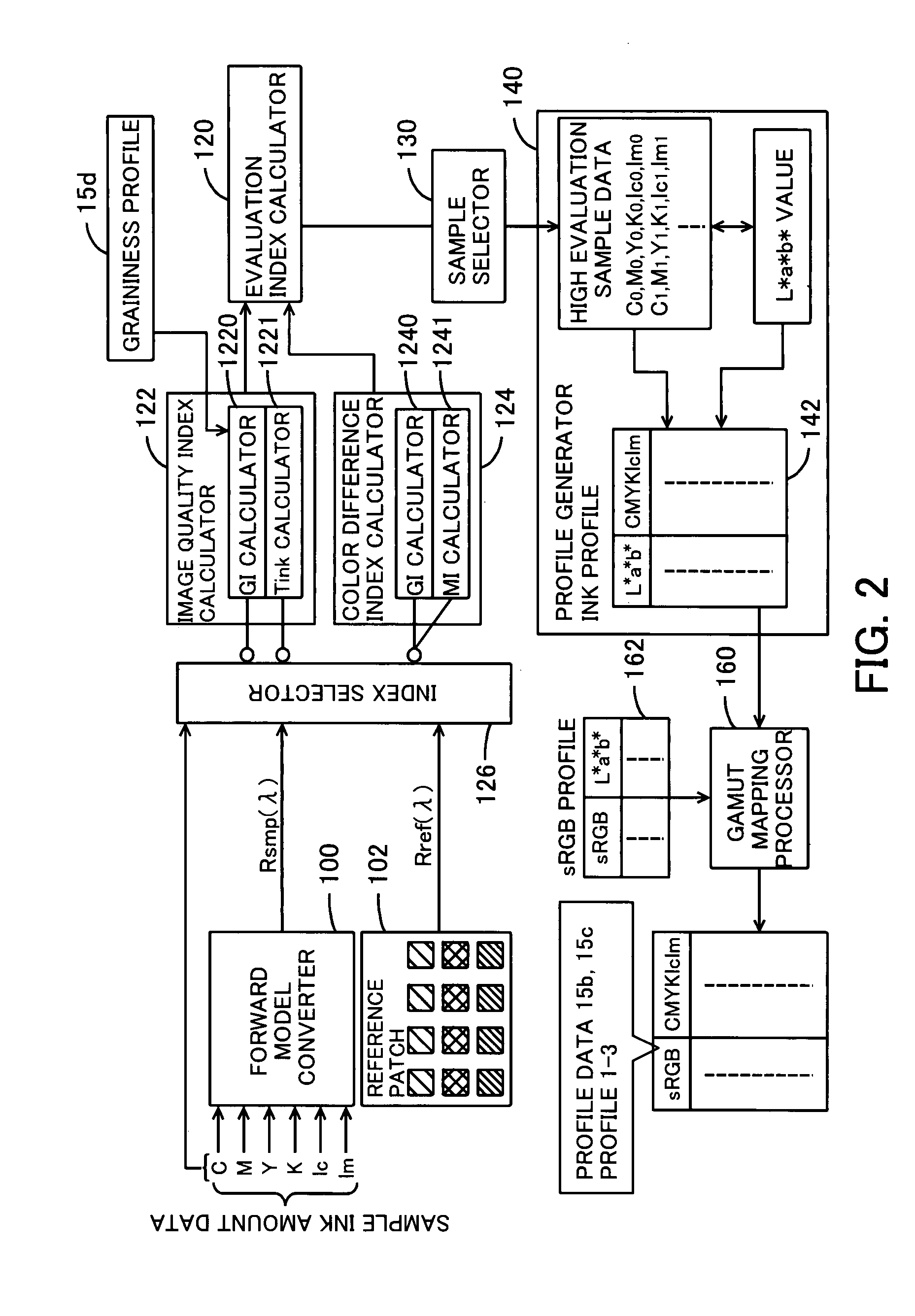Production of color conversion profile for printing
a color conversion and printing technology, applied in the direction of static indicating devices, digitally marking record carriers, instruments, etc., can solve the problems of complex computation and inability to produce profiles quickly
- Summary
- Abstract
- Description
- Claims
- Application Information
AI Technical Summary
Benefits of technology
Problems solved by technology
Method used
Image
Examples
first embodiment
A. First Embodiment
[0055]A-1. Configuration of Color Converter.
[0056]FIG. 1 is a block diagram illustrating the configuration of a color converter that is an first embodiment of the present invention. This color converter is realized by employing a configuration making it possible to implement the color conversion in accordance with the present invention with a computer 10 of general use. It goes without saying that other configurations can be also employed. The computer 10 comprises a CPU and a ROM or a RAM as a storage medium (not shown in the figure) that serve as a computation center and can execute a predetermined program including the program of the present invention, while using a peripheral device such as an HDD 15. An input device for operation such as a keyboard 12 or a mouse 13 is connected to the computer 10 via an I / F 19a, and a display 18 for performing display is also connected to the computer via the I / F 19b. Furthermore, a printer 40 and a scanner 60 are connected t...
example 1
D1. Variant Example 1
[0174]In the embodiments described hereinabove, six inks, namely, CMYKlclm, are used, but ink types are not limited to these and any plural number of inks can be used. However, the use of inks having colors that are equivalent to secondary colors of the basic ink colors CMYK, such as orange ink and green ink is preferred due to a greater degree of freedom as to the shape of spectral reflectance that can be reproduced.
D2. Variant Example 2
[0175]In the first embodiment hereinabove, the color space of calorimetric values is divided into a plurality of cells, and a sample that has the best evaluation index EI within each cell is selected as a representative sample. However, the method for selecting a plurality of representative samples for use in creating a color conversion profile is not limited to the above-described methods; generally, selection of a plurality of representative samples on the basis of an evaluation index EI is possible. For example, it would be p...
example 3
D3. Variant Example 3
[0176]A configuration in which a profile that has been selected in advance by the user is selected and acquired from the HDD 15 is explained by way of an example for the profile selector 33 of the above-described embodiment. However, the profile selection method is not limited to that in this example. For example, because indices that are to be considered when a profile is produced may differ depending on printing conditions, a configuration can be employed in which a profile that has to be selected is determined in advance for each printing condition, and when printing with the printer 40 is performed, the profile is selected based on this printing condition.
[0177]Various approaches may be employed in associating printing conditions with indices that have to be taken into account when a profile is produced. For example, where the printing condition is one of copying an original image, profile data 15c taking the MI into account are preferably selected. With suc...
PUM
| Property | Measurement | Unit |
|---|---|---|
| spectral reflectance Rb( | aaaaa | aaaaa |
| colorimetric | aaaaa | aaaaa |
| color difference index | aaaaa | aaaaa |
Abstract
Description
Claims
Application Information
 Login to View More
Login to View More - R&D
- Intellectual Property
- Life Sciences
- Materials
- Tech Scout
- Unparalleled Data Quality
- Higher Quality Content
- 60% Fewer Hallucinations
Browse by: Latest US Patents, China's latest patents, Technical Efficacy Thesaurus, Application Domain, Technology Topic, Popular Technical Reports.
© 2025 PatSnap. All rights reserved.Legal|Privacy policy|Modern Slavery Act Transparency Statement|Sitemap|About US| Contact US: help@patsnap.com



